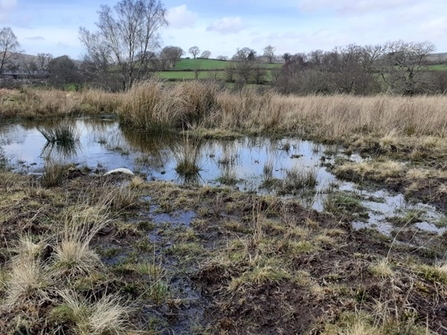
(c) Janice Vincett

(c) Janice Vincett
The definition of peat is that it is the surface organic layer of a soil that consists of partially decomposed organic matter, derived mostly from plant material, which has accumulated under conditions of waterlogging, oxygen deficiency, high acidity and nutrient deficiency (International Peatland Society, 2022).
Peatlands only make up about four per cent of Wales’ land area, and require a very specific set of conditions to exist. They can support livestock and they also naturally manage flood risk by slowing the flow of streams, and providing habitats for a variety of species, Natural Resources Wales, 2023
There are some commonly used terms that are used to describe a peatland, such as:
A mire is a peatland where peat is actively formed. This is an ongoing process. Bogs are peatland that is raised above the landscape and receives rainwater.
Fen is peatland that is formed in a depression in the ground and the water comes from mineral soil or bedrock.
Water logged peat is formed by slow plant decomposition and this locks away the carbon that the plants absorbed from the atmosphere within the soils.
Therefore, the functions of peat are important for the regulation of both our regional and global climate as well as the storage of water.
Currently, there is a UK Peatland Strategy that aims to achieve 50% of peatlands that are conserved in good condition by 2030. According to the International Union of Conservation, peatlands are significant to combat climate change effects on a global scale, and their protection and restoration is needed.
The peatland habitat also has some rare and specialist species such as the round-leaved sundew which is a carnivorous plant that devours insects. Other plants that thrive in peatland are bladderworts and butterworts, sphagnum moss, bog asphodel and bog bean. Wading birds such as Dunlin, Golden Plover and Snipe can be found in upland peatland habitat and will exploit the wide variety of insects and aquatic invertebrates found here.
The Large Heath butterfly is still recorded in some isolated, upland and boggy sites in Wales and the Black Bog ant is a specialist invertebrate that relies upon peatland habitat. It can be found in lowland raised bog in Carmarthen among other suitable areas in the UK.
What is not to love about peat? We need to take care and look after this fantastic natural treasure #LOVEPeat
Some suggested links:
https://www.rwtwales.org/nature-reserves/abercamlo-bog
https://www.wildlifetrusts.org/soils-and-carbon
https://www.wildlifetrusts.org/natural-solutions-climate-change/peatland